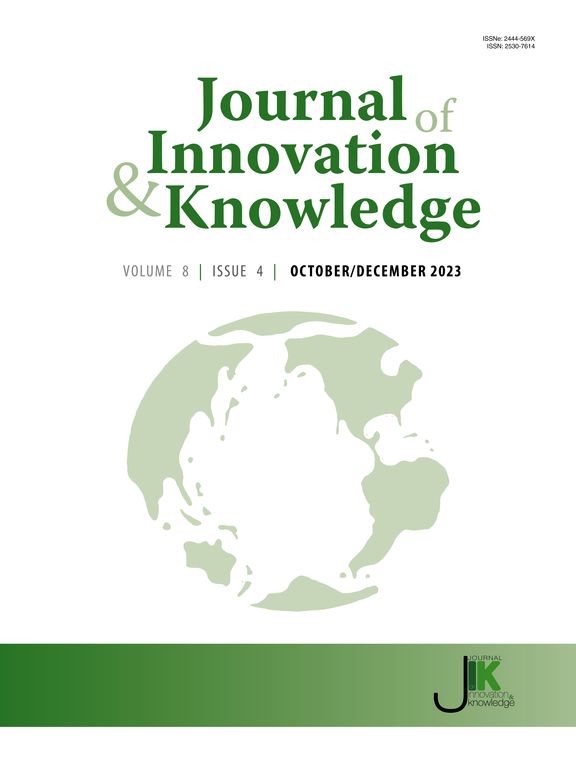艺术创新的艺术:解开创意产业中技术和象征性创新的决定因素——来自加拿大博物馆的证据
IF 15.5
1区 管理学
Q1 BUSINESS
引用次数: 0
摘要
本研究从技术创新和符号创新两方面探讨推动博物馆创新的因素。与以前的研究不同,它采用了一套全面的决定因素来检查它们对技术和符号创新的影响。基于加拿大250家博物馆的数据和多元路径模型,我们同时估计了8种类型的创新,4种类型的技术创新(产品、流程、组织、营销)和4种类型的符号创新(艺术、美学、文化、观众)。研究结果表明,创新似乎是通过内部能力、市场反应和外部关系之间复杂的相互作用而产生的。与资源相关的因素,如技术基础设施、金融资产和艺术能力,在不同类型的创新中表现出不同的影响,这表明在博物馆中,创新不是统一的资源驱动。人力资本、艺术创造力和研发投资表现出更有限或选择性的影响。市场导向,特别是游客导向,成为符号创新的相关驱动因素,而保管导向、协作和共同创造战略的影响较弱或孤立。因此,决定因素在不同类型的创新中是不同的,其中一些是特定于特定类型的创新。此外,研究还揭示了过程与审美创新、艺术与文化创新、审美与受众创新等几对创新类型之间的互补性。技术创新之间的互补性高于符号创新之间的互补性。这些发现突出了博物馆创新的复杂性和偶然性,对博物馆管理者来说,强调了资源整合、市场驱动导向和外部参与策略对成功创新的重要性。本文章由计算机程序翻译,如有差异,请以英文原文为准。
Art of innovating in the arts: Disentangling determinants of technological and symbolic innovations in creative industries— Evidence from Canadian museums
This study investigates the factors driving innovation in museums by incorporating both technological and symbolic innovations. Unlike previous research, it employs a comprehensive set of determinants to examine their impact on technological and symbolic innovations. Based on data from 250 Canadian museums and a multivariate path model, we simultaneously estimate eight types of innovations, four types of technological innovations (product, process, organizational, marketing) and four types of symbolic innovations (artistic, aesthetic, cultural, audience). The findings indicate that innovation appears to emerge through complex interplays between internal capabilities, market responsiveness, and external relationships. Resource-related factors such as technological infrastructure, financial assets, and artistic capabilities show differentiated impacts across types of innovation, suggesting that in museums, innovation is not uniformly resource-driven. Human capital, artistic creativity, and R&D investments demonstrate more limited or selective effects. Market orientation, particularly visitor orientation, emerges as a relevant driver of symbolic innovations, while custodial orientation, collaboration, and co-creation strategies have weaker or isolated impacts. Hence, the determinants differ across types of innovation, with some being specific to particular types thereof. Moreover, the study reveals complementarities between several pairs of types of innovation including Process and Aesthetic innovation, Artistic and Cultural innovation, and Aesthetic and Audience innovation. Finally, the degrees of complementarity between technological innovations are higher than those between symbolic innovations. These findings highlight the complex and contingent nature of innovation in museums, underlining, for museum managers, the importance of resource alignment, market-driven orientation, and external engagement strategies for successful innovation.
求助全文
通过发布文献求助,成功后即可免费获取论文全文。
去求助
来源期刊

Journal of Innovation & Knowledge
Multiple-
CiteScore
16.10
自引率
12.70%
发文量
118
审稿时长
37 days
期刊介绍:
The Journal of Innovation and Knowledge (JIK) explores how innovation drives knowledge creation and vice versa, emphasizing that not all innovation leads to knowledge, but enduring innovation across diverse fields fosters theory and knowledge. JIK invites papers on innovations enhancing or generating knowledge, covering innovation processes, structures, outcomes, and behaviors at various levels. Articles in JIK examine knowledge-related changes promoting innovation for societal best practices.
JIK serves as a platform for high-quality studies undergoing double-blind peer review, ensuring global dissemination to scholars, practitioners, and policymakers who recognize innovation and knowledge as economic drivers. It publishes theoretical articles, empirical studies, case studies, reviews, and other content, addressing current trends and emerging topics in innovation and knowledge. The journal welcomes suggestions for special issues and encourages articles to showcase contextual differences and lessons for a broad audience.
In essence, JIK is an interdisciplinary journal dedicated to advancing theoretical and practical innovations and knowledge across multiple fields, including Economics, Business and Management, Engineering, Science, and Education.
 求助内容:
求助内容: 应助结果提醒方式:
应助结果提醒方式:


